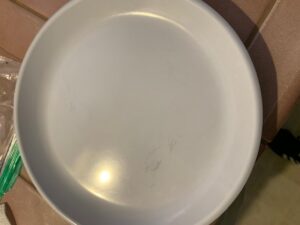 In the 1960s in St. Ann, Missouri, my favorite aunt on Dad’s side, used plastic dinnerware made in the 1950s called Melmac in her modest home. When I visited my cousins I loved the sound of those knives on those Melmac plates around the Formica table in the kitchen. I also loved Aunt Kathleen’s CorningWare teapot, always full. My cousins and me happily ate from those pearl, pink, and turquoise plates for years.
In the 1960s in St. Ann, Missouri, my favorite aunt on Dad’s side, used plastic dinnerware made in the 1950s called Melmac in her modest home. When I visited my cousins I loved the sound of those knives on those Melmac plates around the Formica table in the kitchen. I also loved Aunt Kathleen’s CorningWare teapot, always full. My cousins and me happily ate from those pearl, pink, and turquoise plates for years.
Melmac is made of melamine resin (melamine formaldehyde), a form of plastic laminate used in Formica and laminate flooring, also in today’s whiteboards. American Cyanamid manufactured our family’s Melmac. A German scientist “discovered” melamine in the 1830s but the medium only entered the market in the late 1930s as a fashionable plastic. Melamine, composed of nitrogen, carbon, and hydrogen, combined with formaldehyde and exposed to extreme heat, creates a moldable material that, when cooled, becomes indestructible and dishwasher safe.
In World War II US navy ships used Melmac as dinnerware, and the companies that made it took off. The fact that it could be washed in a machine was HUGE. The popularity lead plastic factories to produce Melmac wares 24 hours a day.
Aunt Kathleen’s Melmac Catches On
The St. Louis based company Branchell developed molded tableware with names like Flair, or Forth, or Flex, or Color Flyte, all forward type names. In the 1950s “modern” meant ease: compatibility with dishwashers and processed foods. The famous designer Russel Wright, began designing melamine for tableware.
Also, a great designer in England discovered the capability of Melmac. In the 1950s innovative designer AH Woodfull, product design unit Head of British Industrial Plastics, designed the material in fabulous forms for the table. “Woody” Woodfull trained in silversmithing and product design. In 1946 he became interested in melamine formaldehyde, the future indeed was ‘plastics.’ Until he retired in 1970 he designed the finest tableware in melamine, including the “Gaydon” and “Melware” lines, revered by collectors of 1960s plastic Melmac tableware designs.
In the 1950s and 60s “modern” people believed Melmac might supplant ceramic tableware. Melmac plates stained and scratched, and only stalwarts kept their Melmac. Aunt Kathleen kept hers! Her set of dishes tells a story of ‘modernity.’ After WWII cheap plastic alternatives to traditional materials for the table lead to traditional materials for the table again rediscovered in 1970s: glazed ceramics that held heat and those without gold or silver designs safe for the dishwasher.
Mid-century modern collectors love Melmac, especially those sets designed by Woodfull or Russell Wright. Magazines from the 1950s are full of ads for Melmac, the ‘wonder plastic.’ Restrictions on certain materials in WWII made plastics a cheap alternative to ceramics. The Northern Industrial Chemical Company of South Boston produced fabulous airline melamine dinnerware people my age remember, and stole. They hired Russell Wright, whose Melmac designs are now featured in the permanent collection at MOMA. Watertown Manufacturing Company made “Lifetime Ware” in 1946, and their designs ALSO live in MOMA’s permanent collection. Another Melmac great was the factory called Hemco Plastics. The 1950s magazine Plastic Living (what a name) put that Connecticut factory “on the map” for their Hemcoware kid’s tableware dishes, also in MOMA’s permanent collection.
Value of Melmac Today?
Collectors seek out pastels of the 1950s and 60s the most. 1970s shades of brown, tan, olive and (yuck) mustards don’t sell as well. Collectors like solid colors, but those 1950-80s abstract florals remain popular. Melmac died down after a good 40 year run in 1980s. Cousin Michael still owns Aunt Kathleen’s set, or maybe only the CorningWare.
Designers to research: Lucent, Fostoria, Russel Wright, Raymond Loewy, and female industrial designers Joan Luntz for Brookville Melamine, and Belle Kogan’s Boonton Belle line. Keep your eyes peeled for those sets sold for vintage camper trailers as a MUST HAVE accessory. You will spend $800 for a larger set as they WORK with those bulbous Airstreams and seem to evoke those days of our youth when a plate also became a frisbee, and no one cared.
You failed to mention the 2 most important Chemists who invented Melmac. The genius chemist who first discovered melamine plastic was Dr Fritz Pollak in 1920 in Vienna. He was the chemist who discovered mixing melamine with formaldehyde produces a resin. Pollak also invented UA plastics such as Beetle and Plaskon and more importantly invented Catalin plastic in 1926 [which most ill informed collectors call Bakelite]. the chemist who further developed melamine plastic was Dr Kurt Ripper – an associate of Dr Fritz Pollak with UA [urea formaldehyde] plastics Dr Kurt Ripper worked for American Cyanamid starting in 1933 and became head chemist for American Cyanamid in 1939 when melamine plastic was first put into production.